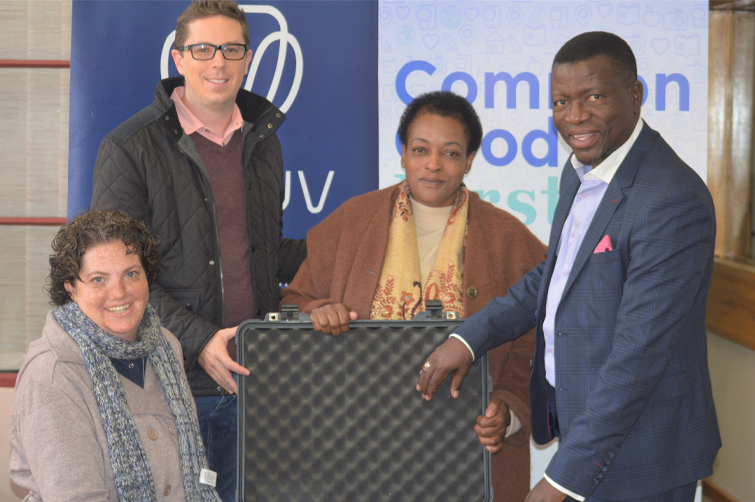Latest News Archive
Please select Category, Year, and then Month to display items
20 December 2019
|
Story Thabo Kessah
|
Photo Thabo Kessah
 Dr Deidré van Rooyen from the Centre for Development Support, Dr Jared McDonald (Department of History), Moodi Matsoso, and Bishop Billyboy Ramahlele with the mobile device.
Dr Deidré van Rooyen from the Centre for Development Support, Dr Jared McDonald (Department of History), Moodi Matsoso, and Bishop Billyboy Ramahlele with the mobile device.
In an effort to broaden the storytelling horizons and to answer to the demands of the Fourth Industrial Revolution, Community Engagement on the UFS Qwaqwa Campus recently launched the Digital Storytelling project, aimed at broadening access to good community stories.
“We have partnered with the Common Good First initiative to enhance the service that we provide as a department,” said Bishop Billyboy Ramahlele, Director: Community Engagement.
“We challenge all academics, support staff, the SRC and students in general, to take advantage of this channel to communicate their stories to the world,” he said.
Histories of royal families
“The digital documentation of the histories of the royal families in the Qwaqwa area is in the pipeline and will be conducted in partnership with the Department of History. We have come to realise that with times changing, the younger generation loses track of the precious histories, and this platform will help in preserving that,” he added.
Community Engagement coordinator, Moodi Matsoso, also revealed that space has been identified for the lab. “At the moment, we are operating on mobile digital storytelling devices, with all the necessary equipment such as tablets and cameras. However, we will soon have a fully-fledged lab on campus,” she said.
This project is co-funded by the Erasmus+ Programme of the European Union.
Researcher works on finding practical solutions to plant diseases for farmers
2017-10-03

Lisa Ann Rothman, researcher in the Department of
Plant Sciences.
Photo: Supplied
Plant disease epidemics have wreaked havoc for many centuries. Notable examples are the devastating Great Famine in Ireland and the Witches of Salem.
Plant diseases form, due to a reaction to suitable environments, when a susceptible host and viable disease causal organism are present. If the interactions between these three factors are monitored over space and time the outcome has the ability to form a “simplification of reality”. This is more formally known as a plant disease model. Lisa Ann Rothman, a researcher in the Department of Plant Sciences at the University of the Free State (UFS) participated in the Three Minute Thesis competition in which she presented on Using mathematical models to predict plant disease.
Forecast models provide promise fighting plant diseases
The aim of Lisa’s study is to identify weather and other driving variables that interact with critical host growth stages and pathogens to favour disease incidence and severity, for future development of risk forecasting models. Lisa used the disease, sorghum grain mold, caused by colonisation of Fusarium graminearum, and concomitant mycotoxin production to illustrate the modelling process.
She said: “Internationally, forecasting models for many plant diseases exist and are applied commercially for important agricultural crops. The application of these models in a South African context has been limited, but provides promise for effective disease intervention technologies.
Contributing to the betterment of society
“My BSc Agric (Plant Pathology) undergraduate degree was completed in combination with Agrometeorology, agricultural weather science. I knew that I wanted to combine my love for weather science with my primary interest, Plant Pathology.
“My research is built on the statement of Lord Kelvin: ‘To measure is to know and if you cannot measure it, you cannot improve it’. Measuring the changes in plant disease epidemics allows for these models to be developed and ultimately provide practical solutions for our farmers. Plant disease prediction models have the potential ability to reduce the risk for famers, allowing the timing of fungicide applications to be optimised, thus protecting their yields and ultimately their livelihoods. I am continuing my studies in agriculture in the hope of contributing to the betterment of society.”